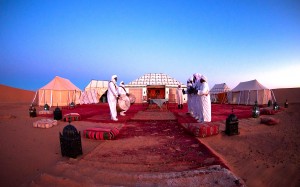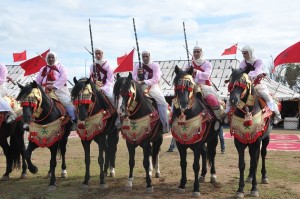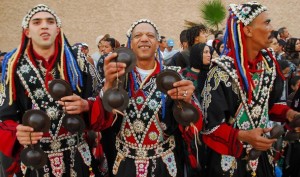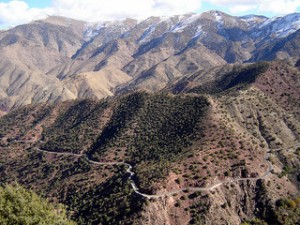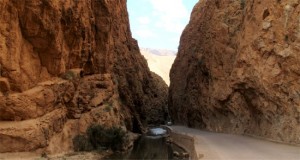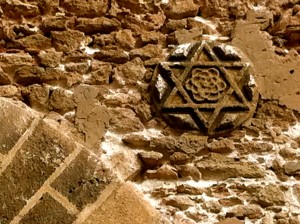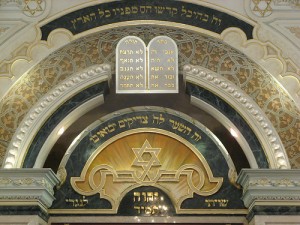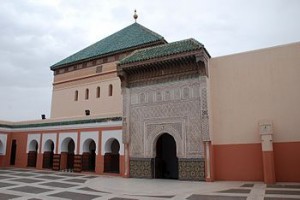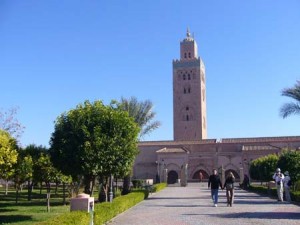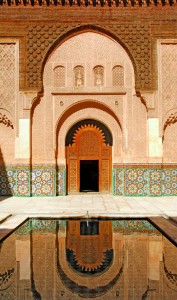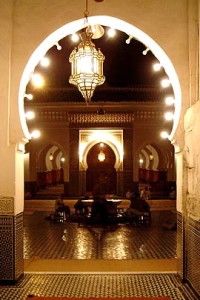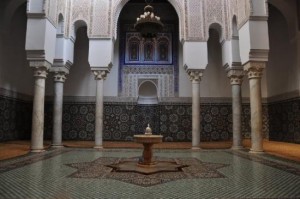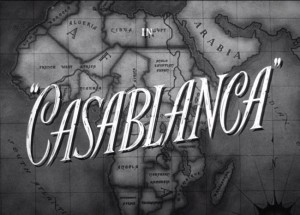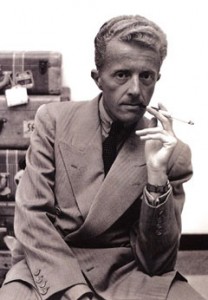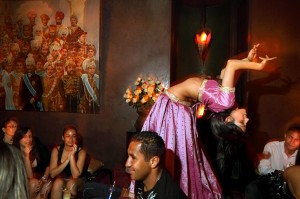
Le Comptoir Darna Marrakech
Marrakech, often referred to as the Paris of Morocco and the premier Moroccan city of night lights and romance has something of a reputation for its nightlife. Marrakech has a reputation for seedy bars and expensive discos in high end hotels with groovy, Ibiza-style discos and belly-dancing along with top end dining experiences that can be had on rooftop terraces.The best places for nightlife in Marrakech are in the wealthy Hivernage district’s 5 star hotels, Sofitel So Lounge, Hivernage Hotel and the Comptoir Darna Cocktail Bar. Low lighting, scented candles, and Moroccan lamps are strategically placed in the ground-floor restaurant of Comptoir. Diners can choose from low-lying tables under the Berber tent, or inside the charcoal and ocher restaurant proper. There is a small garden where you can lounge on the lime, orange, and red cushions and heavy Berber carpets. A wide, central staircase leads up to the real reason to come here: the harem like bar decked out in charcoal, orange, and burgundy veils where resident and guest DJ’s spin the latest in Euro-Arabian dance music with exotic dancers.
One of the hottest places in Marrakech is Theatro, inside the Marrakech Casino at the Hotel es Saadi on avenue Quadissia, Hivernage. Converted from an old theater and with the original stage still intact, this place, at times, rivals Europe with its unabashed on-stage hedonism. At other times, it’s simply a high-end techno dance club.
Out past the Hivernage in the new Aguedal area is Pacha Marrakech. The Pacha complex is on boulevard Mohammed VI,which is large and with loud music to match. This kasbah-style club is an outpost of the clubbing giant Pacha in Ibiza, pumps out 50,000 watts of DJ-mixed pulsating music. It boasts two formal restaurants and a huge swimming pool with a cave like nightclub, with its large open spaces decked out with exotic rugs, high ceiling, and low-lying sitting areas. Regular nightclubers will be at home on the tented dance floor which often looks like a giant circus ring complete with shirtless Europeans, while those hankering for more lounge than reverberating music will gravitate to the separate chill-out lounge. On a Saturday night european and international DJ’s are flown in.
Farther out, on the Ourika road, is Bô & Zin which has French Thai cuisine, served within the various rooms inside. It’s good for a late-night party, with both a resident DJ and guest musicians out in the garden. During summer it’s usually packed with trendy people and a place to have fun where Europeans and locals mix.
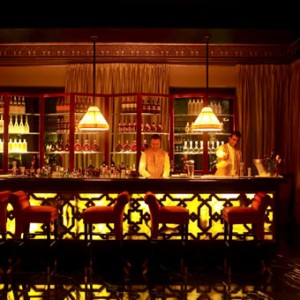
Churchill Bar La Mamounia
All the big hotels in Marrakech also have bars. One of the most glamorous in the city is undoubtedly Le Bar Churchill, at La Mamounia Hotel, which has a sumptuous Moorish and art deco interior and a strict dress code. It is named after the hotel’s most famous guest and is the perfect place for an aperitif in jazzy 1930s style.
There few places in the Marrakech Medina for quality Nightlife as bars are not encouraged to be opened there for religious reasons. An exception is next to the Mellah is the Asian-chic Kosybar, Place des Ferblantiers (lamps) which is very popular. Kosybar is a former riad that offers something different on each of its three floors. The small ground-floor bar, decorated with a zebra-skin hide, is a great spot for an evening of drinking and dancing. The second level combines shades of ocher and olive with heavy, dark-wood furniture and the original zellij flooring. On the terrace you’ll be rewarded with a superb view of the medina, the top of the El Badi Palace, and the resident flock of storks who nest and fly by at eye level. The terrace of Kosybar has comfy lounges and is a great place to chill out with a cold beer or a bottle of wine. Kosybar is open daily from noon to midnight.
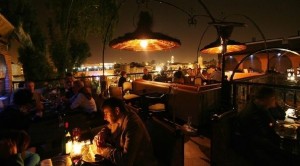
Kosy Bar Marrakech
Also on place des Ferblantiers is Le Tanjia which has a small and popular ground floor bar. Tucked away in a corner you’ll encounter the in-house band, belting out mainly Moroccan and European music. The restaurant upstairs (one floor indoors plus the roof terrace) offers very good fare, mostly Moroccan, and most nights your meal is accompanied by a belly dancer or two. It’s open from noon to midnight.
The Piano Bar, within the mammoth Hotel les Jardins de la Koutoubia, 26 rue Koutoubia is very low-key and rarely busy in the evening. A convenient place for a quick drink just off the Djemma El Fna.
Le Salama on rue des Banques in the Medina attracts a lively crowd of diners, drinkers and dancers. Housed in a period colonial building, this sumptuous club offers Moroccan lanterns, dark floors, mirrored walls, ornamental woodwork and views of the Atlas Mountains.
The Guéliz, the modern part of town, has a number of bars and restaurants and pavement cafés. The old slightly rough Moroccan men only bars are usually hidden away and have screens in the doorway and are not meant for tourists or Europeans. They only sell heineken or local beer.
The Diamant Noir night club is on the Place de la Liberte mixes western pop and Moroccan hits and has an easy-going party atmosphere and a dance floor.
African Chic hosts live music nightly at rue Oum Errabia, El Hara, Marrakech. It offers two huge bars, a great cocktail menu and an explosive atmosphere.
In Guéliz, the restaurants like the Grand Café de la Poste, Kechmara, and Café du Livre are great places to enjoy a drink. Kechmara has live music sessions with a DJ on Wednesdays,Thursdays and Fridays and Café du Livre is a great place of young Moroccans and expats to meet and a very congenial place for tourists to meet locals.
The compact Le Lounge, next to the Diwane Hotel, 24 rue Yougoslavie is Daniel Guillard and Christian Hofer’s affordable, unpretentious lounge bar that nightly attracts a loyal set of locals as well as a few tourists. The staff members are young and friendly. Drinks are served either in the downstairs lounge or the smoky upstairs mezzanine. The interior is sleek and modern, with black and red throughout. The music is largely dance, house, or funk, and widescreen TVs show the latest music videos. There’s a reasonable menu, including tapas.
The Brasserie at the Renaissance Hotel is one of the few restaurants that is open day and night with tables and seating inside around the bar and outside in a screened off area with big television screen for football matches. On the top floor of the Renaissance Hotel is the terrace bar Le Mirador with superb views of Marrakech at night and the Dahab night club with a DJ Jazz and blues.
One must also not forget the ultimate in live music, the nightly concert on Jemaa el Fna. This is the ultimate in live Moroccan music and traditional Gnaoua.
For More Information on Nightlife in Marrakech
Morocco’s Imperial Cities, Seaside Resorts,Sahara Desert,Berber villages, A Taste of Morocco, Magical Kasbahs, Ruins & Waterfalls, Absolute Morocco, The Best of Marrakech, Fes, and Ouarzazate
Travel Exploration specializes in
Morocco Travel. We provide Tours and travel opportunities to Morocco for the independent traveler and tailor-made tours for families and groups with a distinctly unique flavor. From Morocco’s Seven Imperial Cities, to the Magical Sahara Travel Exploration offers a captivating experience that will inspire you. At Travel Exploration we guarantee that you will discover the best of Morocco! Call Travel Exploration at 1 (800) 787-8806 or + 1 (212) 618882681 and let’s book a tour to Morocco for you today.







